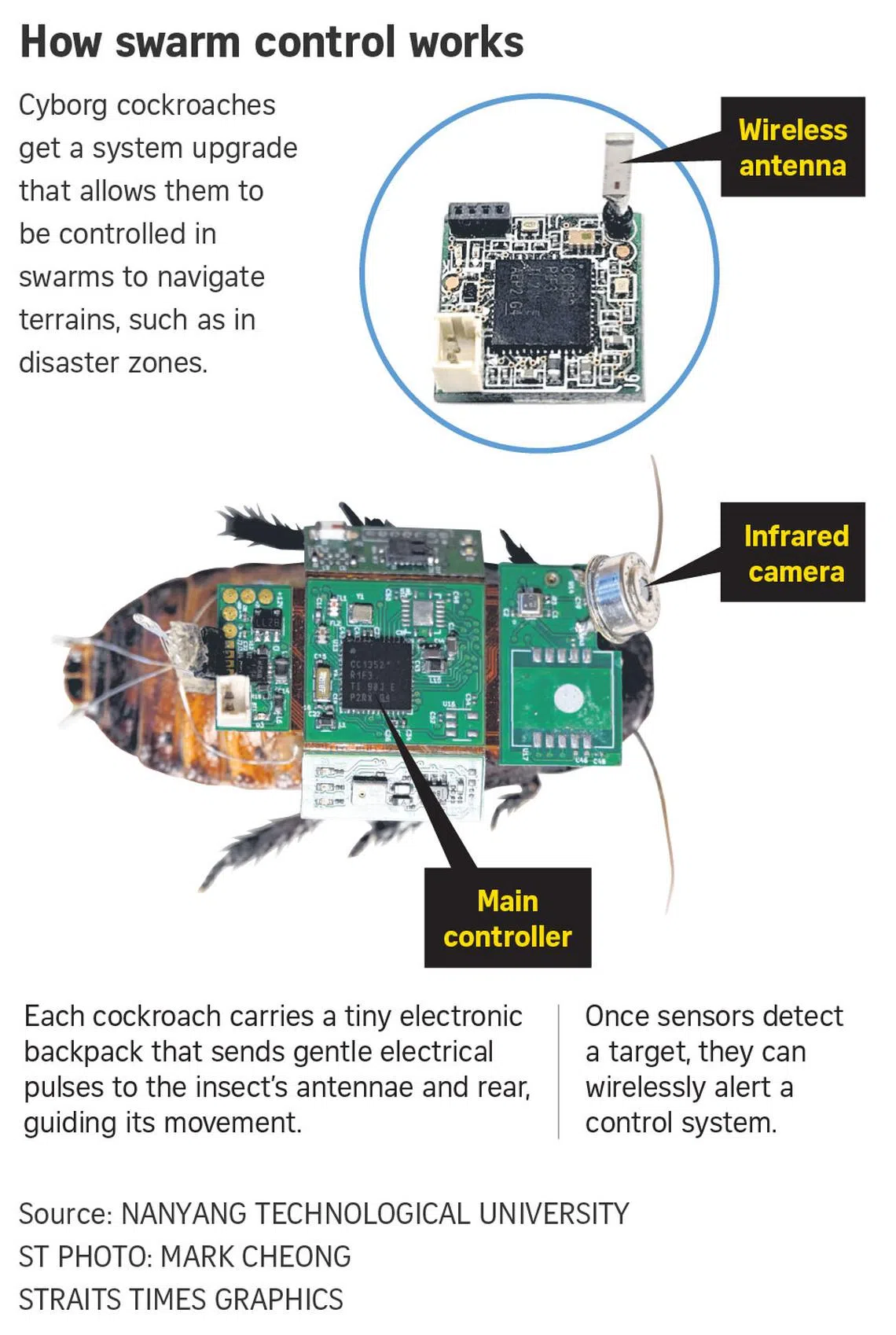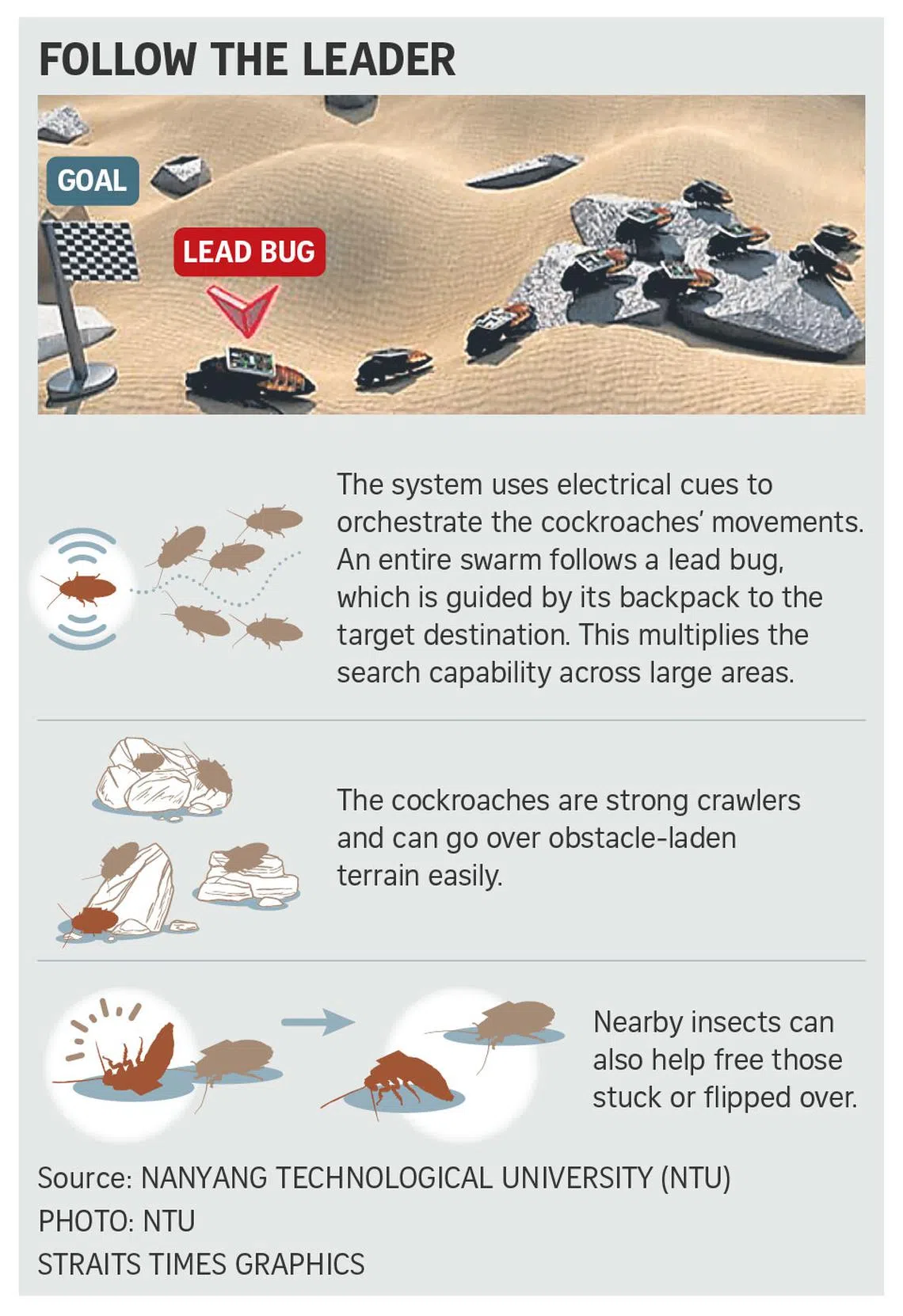Cyborg cockroaches can work as a team for rescue missions with system upgrade
Sign up now: Get ST's newsletters delivered to your inbox

Professor Hirotaka Sato shows a Madagascar hissing cockroach and the electronic device responsible for "swarming".
ST PHOTO: MARK CHEONG
Follow topic:
SINGAPORE – Cyborg cockroaches on search-and-rescue missions can work as a team and follow a leader to cover terrain faster, thanks to a system upgrade developed by researchers in Singapore and Japan.
The cyborg insects can even help each other, flipping over those among them which have turned upside down.
This development marks the latest breakthrough for the Nanyang Technological University (NTU) researchers who developed the technology to control the movement of insects with electronic devices strapped to their backs.
In April 2024, the Home Team Science and Technology Agency (HTX) and NTU showcased the use of the technology
Thumb-size chipsets, equipped with infrared cameras and other tools for search and rescue, are strapped onto the backs of Madagascar hissing cockroaches.
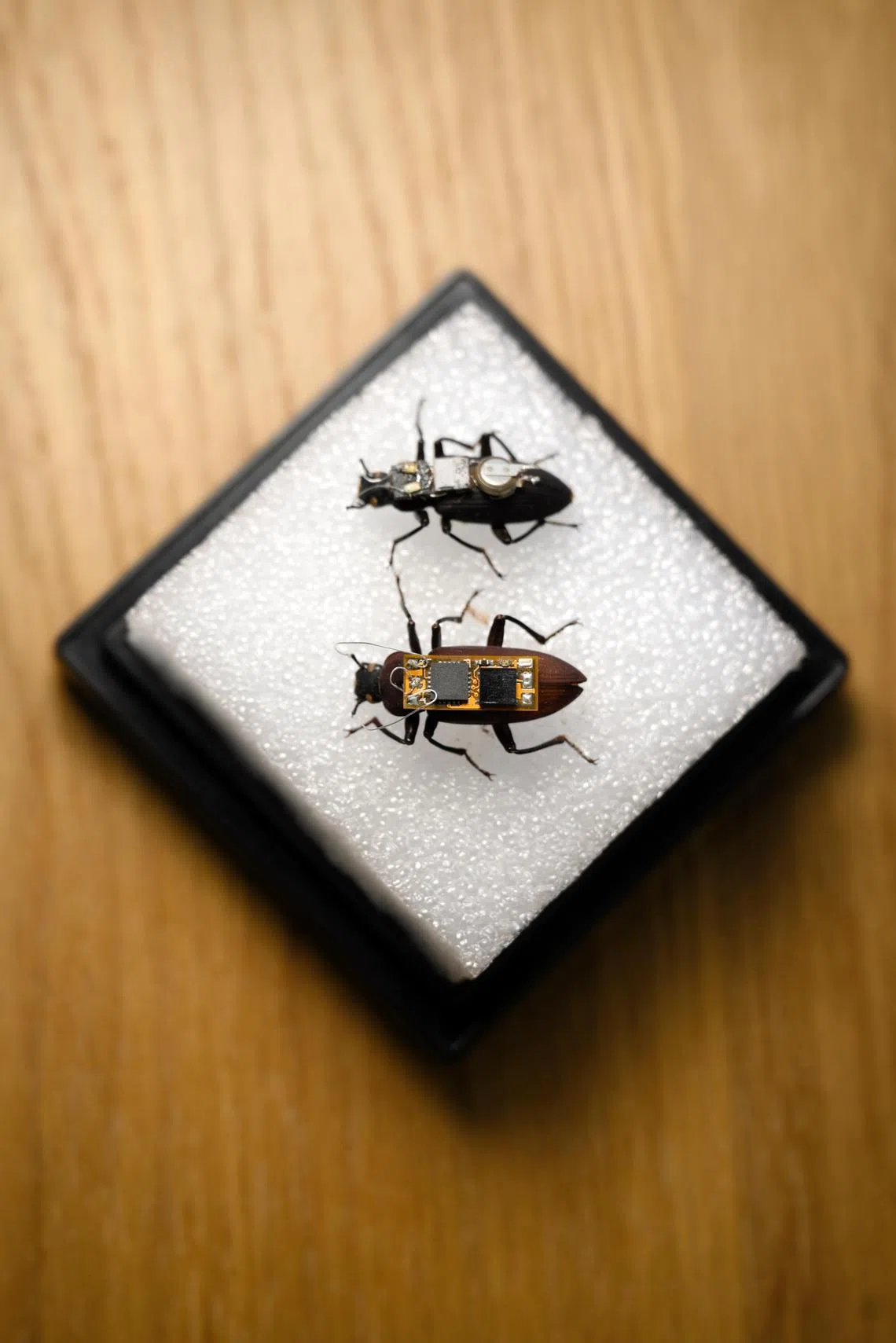
Insects are fitted with electronic devices on their backs.
ST PHOTO: MARK CHEONG
Wires attached to their antennae and rear send gentle pulses to “nudge” the cockroaches to move in a specific direction, by artificially producing the sensation of coming into contact with an obstacle.
Previously, each cockroach was controlled individually.
This is useful, but it is not enough for large-scale operations like earthquake rescue missions, where time is of the essence, said Professor Hirotaka Sato from NTU’s School of Mechanical and Aerospace Engineering, in a recent interview with The Straits Times.
With the upgrade, a swarm of them can be controlled as a group, increasing their effectiveness in finding survivors in a rescue mission or mapping terrain.
An algorithm connects multiple cockroaches through the new miniaturised radio controller unit mounted on their backs.
One insect – perhaps the one nearest to potential survivors – can be appointed as a leader. The leader’s backpack will coordinate with the devices on the other cockroaches to “nudge” them using gentle pulses towards a target.
The NTU team was able to direct the movement of 20 roaches at once.
With more bugs deployed, teams can increase the speed and scale that an area can be scanned in search-and-rescue missions, infrastructure inspection or environmental monitoring, such as on farms.
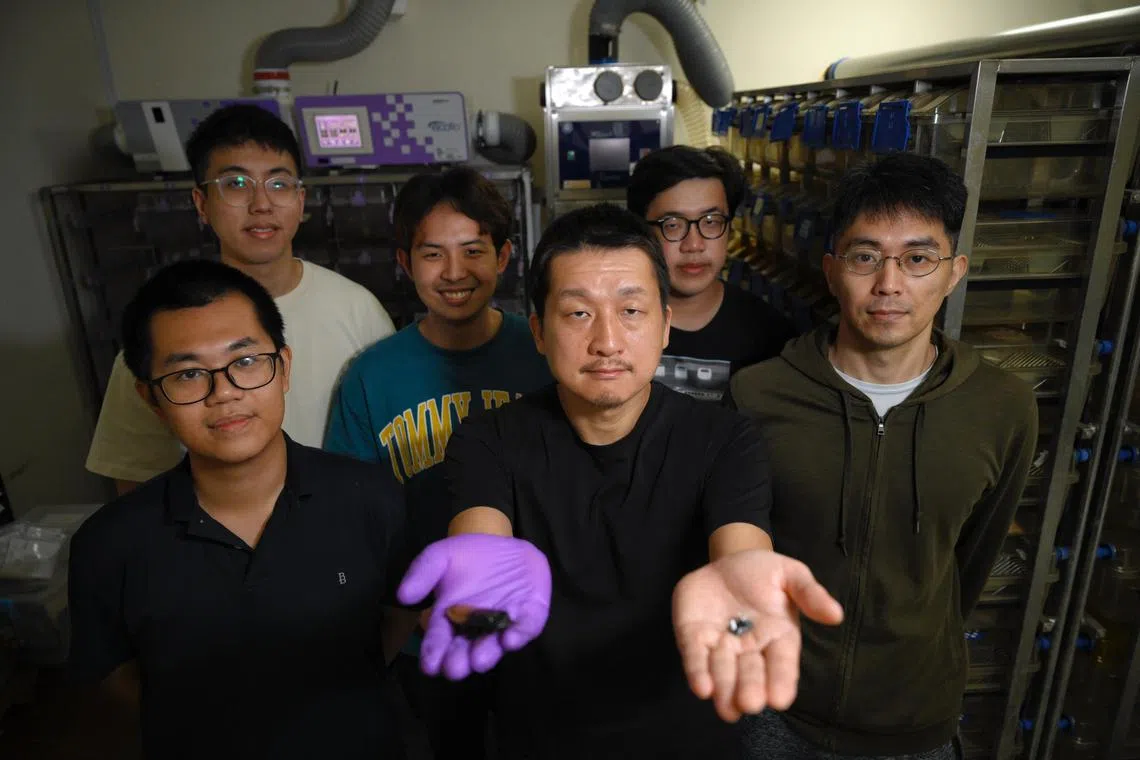
Professor Hirotaka Sato (centre) shows a Madagascar hissing cockroach and an electronic device responsible for “swarming”. With him are team members (from left) Mr Le Duc Long, Mr Marcus Wong, Mr Greg Angelo Gonzales Nonato, Mr Yu Xiang See To and Mr Kai Kazuki.
ST PHOTO: MARK CHEONG
The experiments in NTU were conducted using a swarm-control algorithm developed by Professor Masaki Ogura from Hiroshima University and Professor Wakamiya Naoki from Osaka University. The joint research effort was published in peer-reviewed scientific journal Nature Communications in January.

Scientists coordinated the movement of some 20 cyborg cockroaches in tests at NTU.
PHOTO: NANYANG TECHNOLOGICAL UNIVERSITY
The team wrote that cockroaches are naturally adept in navigating tricky terrain and do not tire easily, unlike machines, which, at this stage, do not have sufficient battery life for long missions.
The swarming algorithm puts these helpful traits to use en masse, harnessing the bugs’ natural instincts with precise control, they said.
As research progressed, the team found that letting the insects navigate on their own appeared more effective than constantly nudging them.
“Instead of forcibly trying to control them precisely, we found that taking a more relaxed and rough approach not only worked better but also led to more cooperative actions,” Prof Naoki said.
With greater freedom, the cyborg bugs found themselves trapped far less often. Clusters of insects also helped to flip others who had turned upside down as they moved past each other.
Such actions could have been tough to design in an algorithm, said Prof Naoki. “This was a remarkable discovery.”
Mr Ong Ka Hing, deputy director of ground systems at HTX, said swarm technology offers a significant advance in search-and-rescue innovation, promising faster and more coordinated search operations.
Swarming technology expands the potential uses of cyborg insects, said Mr Ong.
Currently, HTX, NTU, and Klass Engineering are focusing on the deployment of cyborg bugs to cover large areas and locate survivors, he said.
HTX plans to deploy the cyborg bugs in real operations within three years.
Prof Sato’s work on hybrid insects, beginning with his first prototype in 2008, is among the earliest in the field globally. His work was recognised in 2009 as one of Time Magazine’s 50 Best Inventions and among 10 Emerging Technologies by MIT Technology Review.
Researchers in Japan, China and Australia are showing increasing interest in cyborg insects, each pursuing their own research projects.
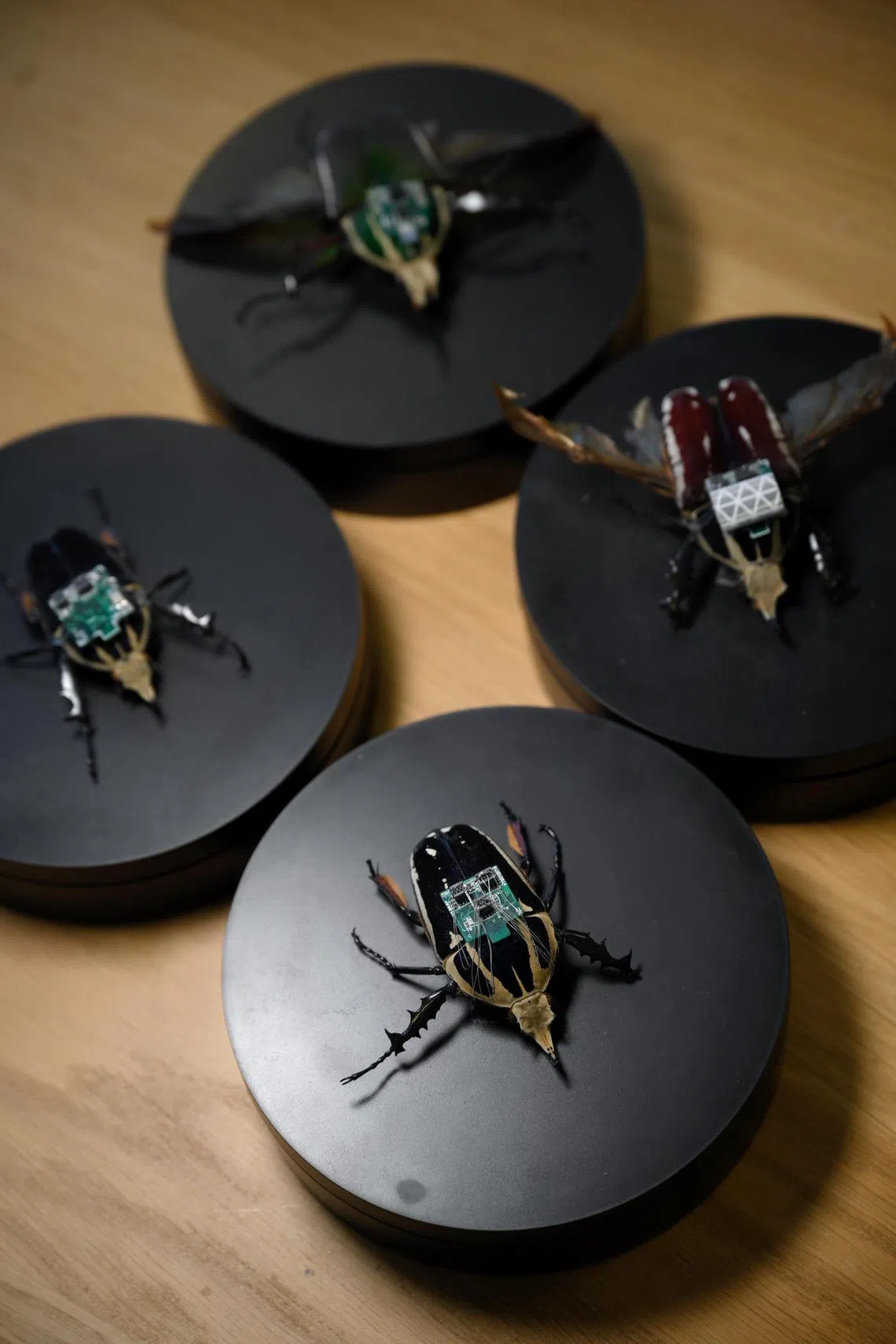
Insects fitted with an electronic device on its back, as seen at Nanyang Technological University on Feb 3.
ST PHOTO: MARK CHEONG
“Battery-operated robots might last a few minutes due to high power consumption,” said Prof Sato.
With insects, energy in the onboard battery can be saved for other functions like radio communication and sensors, extending the battery life.
“That is important in the field, because it can take hours before survivors are detected,” said Prof Sato.
His team plans to develop algorithms to coordinate more complex tasks among cyborg insects, like transporting objects.
They have also applied the technology to other insects, like beetles, and are testing it on crabs to perform searches underwater.
